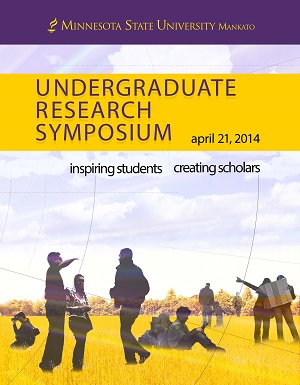Event Title
Morphological and Molecular Barcode Characteristics of Parasites from Family Strigeidae Collected from Lake Winnibigoshish
Location
CSU Ballroom
Start Date
21-4-2014 10:00 AM
End Date
21-4-2014 11:30 AM
Student's Major
Biological Sciences
Student's College
Science, Engineering and Technology
Mentor's Name
Robert Sorensen
Mentor's Email Address
robert.sorensen@mnsu.edu
Mentor's Department
Biological Sciences
Mentor's College
Science, Engineering and Technology
Description
Identification of parasites can be problematic as many species go through complex life cycles. To make matters for identification worse, plasticity of an organism can allow adaptations to a different species of host, which may incorrectly suggest a different or subspecies of a parasite. In 2012, ducks and waterfowl were recovered from hunters by Holly Bloom, a graduate student of MSU, from the northern Minnesota lake, Lake Winnibigoshish. Inside the intestines of these waterfowl, which included mallard, ring neck, blue wing teal, and scaup, a number of similar parasites were found. The parasites initially were suspected to be of Family Strigeidae, a family of trematodes. The identity of the suspected individuals has been confirmed to be the species Cotylurus brevis and Cotylurus flabelliformis. Confirmation of the identity was made from characteristics made visible by microscopy, both stained and SEM. Such characteristics included testis orientation and size, ovary ratio, body ratio, and sizes of ventral and oral suckers. Ranges obtained and observations of sizes and morphology of the worms’ organs were comparable to past studies by Nasir (1962) and Dubois (1950). We sequenced a portion of the cytochrome oxidase gene to aid in the identification of these worms. This will be helpful in future studies, because although morphology may change through the parasites life cycle or in relation to the host, its genetic markers should reveal an accurate identification.
Morphological and Molecular Barcode Characteristics of Parasites from Family Strigeidae Collected from Lake Winnibigoshish
CSU Ballroom
Identification of parasites can be problematic as many species go through complex life cycles. To make matters for identification worse, plasticity of an organism can allow adaptations to a different species of host, which may incorrectly suggest a different or subspecies of a parasite. In 2012, ducks and waterfowl were recovered from hunters by Holly Bloom, a graduate student of MSU, from the northern Minnesota lake, Lake Winnibigoshish. Inside the intestines of these waterfowl, which included mallard, ring neck, blue wing teal, and scaup, a number of similar parasites were found. The parasites initially were suspected to be of Family Strigeidae, a family of trematodes. The identity of the suspected individuals has been confirmed to be the species Cotylurus brevis and Cotylurus flabelliformis. Confirmation of the identity was made from characteristics made visible by microscopy, both stained and SEM. Such characteristics included testis orientation and size, ovary ratio, body ratio, and sizes of ventral and oral suckers. Ranges obtained and observations of sizes and morphology of the worms’ organs were comparable to past studies by Nasir (1962) and Dubois (1950). We sequenced a portion of the cytochrome oxidase gene to aid in the identification of these worms. This will be helpful in future studies, because although morphology may change through the parasites life cycle or in relation to the host, its genetic markers should reveal an accurate identification.
Recommended Citation
Swedberg, Rachael Yates and Yuko Nakamura. "Morphological and Molecular Barcode Characteristics of Parasites from Family Strigeidae Collected from Lake Winnibigoshish." Undergraduate Research Symposium, Mankato, MN, April 21, 2014.
https://cornerstone.lib.mnsu.edu/urs/2014/poster_session_A/16



